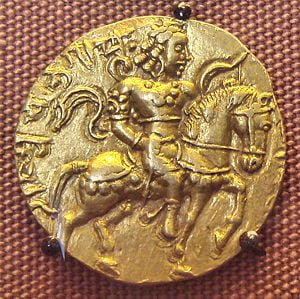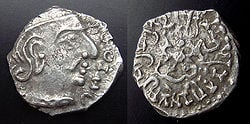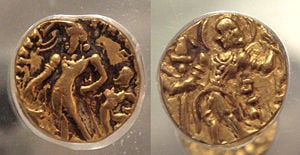Chandragupta II
| Chandragupta hi II Vikramaditya | ||
|---|---|---|
| Gupta emperor | ||

| ||
| Coin of Chandragupta II. British Museum. | ||
| Reign | 375 - 415 C.E. | |
Chandragupta II (referred to as Vikramaditya or Chandragupta Vikramaditya) stands as one of the most powerful emperors of the Gupta empire. His rule spanned from 375 to 415 C.E. when the Gupta empire achieved its zenith, often referred to as the Golden Age of India. Chandragupta had been the son of the ruler Samudragupta. He attained success by pursuing both favorable military alliances and an aggressive expansionist policy. In that both his father and grandfather set the precedent.
In addition to military prowess, Chandragupta II elevated culture, art, mathematics, philosophy, religion, and astronomy during his reign. He sponsored a circle of poets known as the Nine Gems, foremost among them the renowned Kalidasa. In astronomy and mathematics, Varahamihira stood at the forefront. In art, the relief panels on the Dashavatara Temple in Deogarh provide an example of the heights reached by Gupta artists. In the area of religion, Chandragupta II supported Buddhism during the time of Buddhism's ascendancy in northern India, as well as Hinduism and Jainism.
Early Reign
Few personal details have been recorded of the great king. His mother, Datta Devi, had been the chief queen of Samudragupta. The most widely accepted details have been built upon the plot of the play 'Devi-Chandraguptam' of Vishakadatta. The play has been lost with only fragments preserved in other works (Abhinava-bharati, Sringara-prakasha, Natya-darpana, Nataka-lakshana Ratna-kosha). An Arabic work Mujmalu-t-Tawarikh, using a corruption of the name Vikramaditya, tells a similar tale of a king.
The fragment from Natya-darpana mentions the king Ramagupta, the elder brother of Chandragupta, surrendering his queen Dhruvaswamini to the Saka king of the Western Kshatrapas Rudrasimha III, after a defeat at the Saka king's hands. To avoid the ignominy the Guptas decided to send Madhavasena, a courtesan and a beloved of Chandragupta, disguised as the queen. Chandragupta changed the plan and himself went to the Saka King disguised as the queen. He then kills Rudrasimha and later his own brother, Ramagupta. Dhruvaswamini then marries Chandragupta.
Although Vishakadatta may have taken liberties took with the incidents, Dhruvadevi indeed had been the king's chief queen as seen in the Vaisali terracotta seal that calls her âMahadeviâ Dhruvasvamini. The Bilsad pillar inscription of their son Kumara Gupta I also refers to her as Mahadevi Dhruvadevi. Inscriptions on Jain figures in the District Archaeological Museum, and some copper coins found at Vidisha, mention a Ramagupta. The king and Dhruvadevi constitute the protagonists of Vishakadatta's play indicating that the playwright had given little, if any, significance to marrying his widowed sister-in-law. Later Hindus viewed such a marriage as morally distasteful, censure of the act appearing in the Sanjan copperplate inscription of Amoghavarsha I and in the Sangali and Cambay plates of the Rashtrakuta king Govinda IV.
The Allahabad pillar inscription mentions the marriage of Chandragupta with a Naga princess Kuberanaga. A pillar from Mathura referring to Chandragupta (Candragupta) has recently been dated to 388 C.E.[2] Chandragupta's daughter Prabhavati by his other queen Kuberanaga, a Naga princess, married the powerful Vakataka king Rudrasena II.
Later Reign
Faxian (Fa-shien) had been the first of three great Chinese pilgrims who visited India from the fifth to the seventh centuries C.E. in search of knowledge, manuscripts and relics. He arrived during the reign of Chandragupta II and gave a general description of North India at that time. Among other things, he reported the absence of capital punishment, the lack of a poll-tax and land tax, and the presence of a strongly embedded caste system. Most citizens abstained from onions, garlic, meat and wine. The Chandalas proved the exception, earning the displeasure of other peoples and finding themselves segregated in mixed society.
Culturally the reign of Chandragupta II marked a Golden Age as well. Later reports of the presence of a circle of poets known as the Nine Gems in his court give evidence of that. Kalidasa stood as the greatest among them. He authored numerous immortal pieces of literature, including The Recognition of Shakuntala, earning the title of the Shakespeare of India.[3] Varahamihira, a famous astronomer and mathematician, had been another.[4]
Padwa or Varshapratipada, which marks the coronation of King Vikramaditya, follows the day after the Hindu festival Diwali. The Hindu Shaka-Samvat calendar apparently started on that day, celebrated as New Year's day in some places. That leads to confusion since the Vikram-Samvat synchronizes with the Vikram-Samvat calendar, starting around April, in parts of India.
Campaigns Against Neighboring Kingdoms
Fourth century C.E. Sanskrit poet Kalidasa, credits Chandragupta Vikramaditya (Raghu) with having conquered about twenty one kingdoms, both in and outside India. After finishing his campaign in the East, South and West India, Raghu (aka Vikramaditya, Chandragupta II) proceeded northwards, subjugated the Parasikas (Persians), then the Hunas and the Kambojas tribes located in the west and east Oxus valleys respectively. Thereafter, the victorious king proceeded across the Himalayas, reducing the Kinnaras, Kiratas and lands into India proper.
According to the Brihat-Katha-Manjari of the Kashmiri Pandit Kshmendra, king Vikramaditya (Chandragupta II) had "unburdened the sacred earth of the Barbarians like the Shakas, Mlecchas, Kambojas, Yavanas, Tusharas, Parasikas, Hunas, etc. by annihilating these sinful Mlecchas completely."
The Empire
His greatest victory had been over the Shaka-Kshatrapa dynasty and annexation of their kingdom in Gujarat, by defeating their last ruler Rudrasimha III. His son-in-law Rudrasena II died fortuitously after a brief reign in 390 C.E., following which Prabhavatigupta ruled as a regent on behalf of her two sons. During that twenty year period, the Vakataka realm practically became a part of the Gupta empire. The geographical location of the Vakataka kingdom allowed Chandragupta to take the opportunity to defeat the Western Kshatrapas conclusively. Historians typically refer to that period as the Vakataka-Gupta age.
Chandragupta II controlled a vast empire, from the mouth of the Ganges to the mouth of the Indus River and from today's North Pakistan south to the mouth of the Narmada. Pataliputra continued to serve as the capital of his expansive empire but Ujjain found itself relegated to a second capital status. The abundant beautiful gold coins issued by the Gupta dynasty testify to the imperial grandeur of that age. Chandragupta II also introduced production of silver coins in the Shaka tradition.
The famous iron pillar
Close to the Qutub Minar stands one of Delhi's most curious structures, an iron pillar, dating back to fourth century C.E. The pillar bears an inscription declaring that the artisans created it to serve as a flagstaff in honor of the Hindu god Vishnu, and in the memory of Chandragupta II. The pillar also highlights ancient India's achievements in metallurgy. The pillar, created with 98 percent wrought iron, has stood more than 1,600 years without rusting or decomposing. That iron pillar bares similarity to the Pillars of Ashoka found mostly in northern India. From Chandragupta II, kings bore the title Parama Bhagavatas, or Bhagavata Vaishnavas. The Bhagavata Purana entails the fully developed tenets and philosophy of the Bhagavata sect whereas Krishna fused with Vasudeva, transcending Vedic Vishnu and cosmic Hari turning into the ultimate object of bhakti.[5]
|
| ||
|---|---|---|
| Preceded by: Samudragupta |
Gupta Emperor 375 â 414 |
Succeeded by: Kumara Gupta I |
Notes
- â E. J. Rapson, Catalogue of the coins of the Andhra dynasty: the western Ksatrapas, the TraikÅ«á¹aka dynasty and the "Bodhi" dynasty, with one map and twenty-one plates (New Delhi: Asian Educational Services, 1989), cli.
- â Harry Falk, "The Kaniá¹£ka era in Gupta Records," in Institute of Silk Road Studies. Silk Road art and archaeology. (Kamakura-shi Japan: Institute of Silk Road Studies, 1990), 167-176.
- â KÄlidÄsa and Somadeva Vasudeva, The recognition of Shakúntala. The Clay Sanskrit library (New York: New York University Press, 2006).
- â G. Thibaut Varahamihira and Sudhakara Dvivedi, The Panchasiddhantika, the astonomical work of Varaha Mihira (Varanasi: Chowkhamba Sanskrit Series Office, 1968).
- â Kalyan Kumar Ganguli, Sraddh njali, Studies in Ancient Indian History, D.C. Sircar Commemoration: Puranic tradition of Krishna (Sundeep Prakashan: 1988), 36.
ReferencesISBN links support NWE through referral fees
- Institute of Silk Road Studies. Silk Road art and archaeology. Kamakura-shi, Japan: Institute of Silk Road Studies, 1990. OCLC 187452343
- Joshi, M. C., and S. K. Gupta. King Chandra and the Meharauli Pillar. Kusumanjali problems of Indian history series, no. 1. Meerut, India: Kusumanjali Prakashan, 1989. OCLC 22093394
- KÄlidÄsa, and Somadeva Vasudeva. The recognition of Shakúntala. The Clay Sanskrit library. New York: New York University Press, 2006. ISBN 978-0814788158
- Kulke, Hermann, and Dietmar Rothermund. A history of India. London: Routledge, 1998. ISBN 978-0415154819
- Mukerji, Radha Kumud. The Gupta empire. Delhi: Motilal Banarsidass, 1973. OCLC 59795845
- Majumdar, R. C. Ancient India. Delhi: Motilal Banarsidass, 1964. OCLC 1075813
- Pandey, Rajbali. Chandragupta II VikramÄditya. Chaukhamba Amarabharati studies, v. 8. Varanasi, U.P., India: Chaukhamba Amarabharati Prakashan, 1982. OCLC 9160631
- Rapson, E. J. Catalogue of the coins of the Andhra dynasty: the western Ksatrapas, the TraikÅ«á¹aka dynasty and the "Bodhi" dynasty, with one map and twenty-one plates. New Delhi: Asian Educational Services, 1989. ISBN 978-8120605220
- Shastri, Hara Prasad. King Chandra of the Meharauli Iron Pillar inscription. Ames Library pamphlet collection, 58:12. Bombay: British India Press, 1913. OCLC 85335643
- Sircar, Dineschandra, Kalyan Kumar Dasgupta, Pranab Kumar Bhattacharyya, and R. D. Choudhury. SraddhÄnjali, studies in ancient Indian history: D.C. Sircar commemoration volume. Delhi: Sundeep Prakashan, 1988. ISBN 978-8185067100
- Varahamihira, G. Thibaut, and Sudhakara Dvivedi. The Panchasiddhantika, the astonomical work of Varaha Mihira. Varanasi: Chowkhamba Sanskrit Series Office, 1968. OCLC 221916808
External Links
All links retrieved December 3, 2023.
Credits
New World Encyclopedia writers and editors rewrote and completed the Wikipedia article in accordance with New World Encyclopedia standards. This article abides by terms of the Creative Commons CC-by-sa 3.0 License (CC-by-sa), which may be used and disseminated with proper attribution. Credit is due under the terms of this license that can reference both the New World Encyclopedia contributors and the selfless volunteer contributors of the Wikimedia Foundation. To cite this article click here for a list of acceptable citing formats.The history of earlier contributions by wikipedians is accessible to researchers here:
The history of this article since it was imported to New World Encyclopedia:
Note: Some restrictions may apply to use of individual images which are separately licensed.

